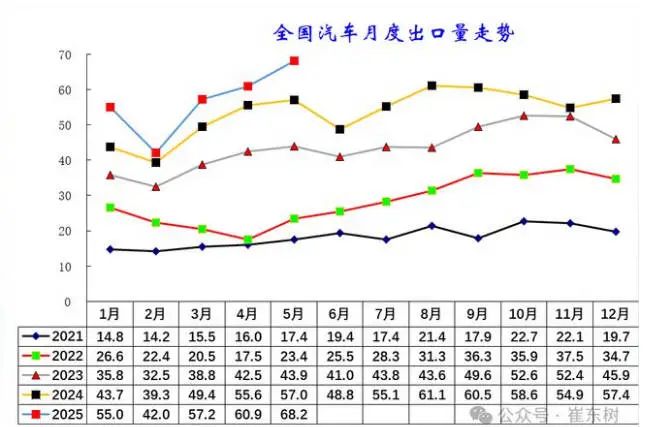China exported 682,000 vehicles in May, with new energy vehicles accounting for 43%
China's new energy vehicle exports performed better than expected in January-May 2025, mainly because plug-in hybrid and hybrid vehicles replaced pure electric vehicles as new growth points for export growth, especially plug-in hybrid pickup trucks, which performed well and became a highlight of commercial vehicle new energy vehicle exports. China's new energy vehicle exports to the Middle East and developed countries showed a high-quality development situation, mainly exported to Western Europe and Asia. The decline in the fuel vehicle market in Russia was fully reflected, while the retail volume in the Russian market declined slightly. Among them, the main Chinese automakers such as Geely (00175), Changan, Chery, BYD (334.240, -3.20, -0.95%) (002594.SZ), etc. performed very well.

Monthly trend of vehicle exports
From January to May 2025, China's automobile exports reached 2.83 million units, a year-on-year growth of 16% from January to May 2024. In May, China's automobile exports reached 682,000 units, a year-on-year increase of 20% and a month-on-month increase of 12%. The overall year-on-year and month-on-month trends were relatively strong; the main driving force this year is still the improvement of the competitiveness of Chinese products and the slight growth of the global southern countries market, but the international brands in the Russian market under the Russia-Ukraine crisis may be fully replaced by Chinese cars. The cycle of adjustment is likely to be deeper.
The top 10 countries in terms of China's total automobile exports in May 2025 are: Mexico 51,927, UAE 50,493, Brazil 47,454, Australia 33,290, Belgium 31,118, UK 29,393, Saudi Arabia 27,579, Philippines 26,944, Russia 21,925, Kazakhstan 17,788. The top five countries with the largest increase in volume compared with the same period are: UAE 21,625, Australia 18,237, Philippines 16,181, Kazakhstan 11,052, Mexico 9,371.
The top 10 countries with the total total vehicle exports in 2025 are: Mexico 239,709 vehicles, UAE 189,547 vehicles, Russia 153,664 vehicles, Brazil 140,993 vehicles, Belgium 125,110 vehicles, Australia 124,196 vehicles, Saudi Arabia 119,564 vehicles, the United Kingdom 107,634 vehicles, the Philippines 97,689 vehicles, and Turkey 70,929 vehicles. Among them, the top five countries with increased growth compared with the same period in this period are: UAE 74,046 vehicles, Mexico 47,595 vehicles, Australia 42,561 vehicles, the Philippines 32,681 vehicles, and Kazakhstan 31,622 vehicles. In 2025, the Middle East market will become the core market for growth.
In May 2025, China's new energy (2.680, -0.04, -1.47%) automobile exports were 296,000 vehicles, an increase of 43%, accounting for 43% of automobile exports, an increase of 7 percentage points from the new energy export share in May 2024. From January to May 2025, the export volume of new energy vehicles was 1.16 million, a year-on-year increase of 33%, which was much higher than the 29% growth rate from January to May 2024, accounting for 41% of automobile exports, 5 percentage points higher than the export share of new energy vehicles from January to May 2024.
The top 10 countries in terms of China's total new energy vehicle exports in May 2025: Brazil 35,478 vehicles, Belgium 30,405 vehicles, the Philippines 21,517 vehicles, the United Kingdom 21,456 vehicles, Mexico 14,587 vehicles, Australia 14,250 vehicles, Turkey 11,341 vehicles, South Korea 10,436 vehicles, India 10,334 vehicles, Spain 8,751 vehicles, among which the top five countries with increased growth compared with the same period in this period were: Philippines 14,506 vehicles, Turkey 8,143 vehicles, Spain 6,181 vehicles, Australia 6,151 vehicles, and Mexico 5,899 vehicles.
The top 10 countries in terms of China's total new energy vehicle exports from January to May 2025: Belgium 119,678 vehicles, Brazil 105,513 vehicles, Mexico 84,862 vehicles, the Philippines 73,295 vehicles, the United Kingdom 72,725 vehicles, Australia 56,637 vehicles, Turkey 54,260 vehicles, Thailand 52,347 vehicles, the United Arab Emirates 37,723 vehicles, and India 37,377 vehicles. Among them, the top five countries with increased growth compared with the same period in this period are: Mexico 55,485 vehicles, Turkey 43,222 vehicles, the Philippines 28,170 vehicles, Indonesia 17,493 vehicles, and Australia 17,299 vehicles.
In 2025, exports to Belgium, Mexico, Brazil, Thailand and other Southeast Asian countries are the main directions. Recently, exports to markets such as Brazil, Russia, and Canada are relatively weak. Turkey, Israel, India, and Malaysia are two markets that have performed relatively well.
From the monthly trend, exports in recent years still show seasonal characteristics, showing the characteristics of summer high and domestic contrast trend. The auto market started strongly in 2022, but the export volume in February-May, affected by the Shanghai epidemic, showed a month-on-month decline, and continued to rise from May to December. Exports continued to remain strong in 2023. China's automobile exports in 2024 are basically in line with the gradual strengthening trend of previous years.
The growth rate in January 2025 was relatively strong. From February to May, with the interference of Trump's tariffs, the month-on-month growth in May was strong, and the growth rate of China's automobile exports was less affected.
The export growth rate of passenger cars in 2025 fell sharply, among which the export growth rate of gasoline cars and pure electric cars was low, and both fell in May. This year, the export of hybrid passenger cars is very strong, and the export growth rate of plug-in hybrids is the strongest. This year, the export of trucks and buses is stable, and the fluctuation of passenger car exports to Russia and Europe is the core turbulent variable.
From January to May 2025, the proportion of pure electric passenger cars rebounded, and the exports of gasoline passenger cars and gasoline buses declined significantly. Among them, the exports of plug-in hybrid and hybrid passenger cars in May rebounded significantly month-on-month.
MORE